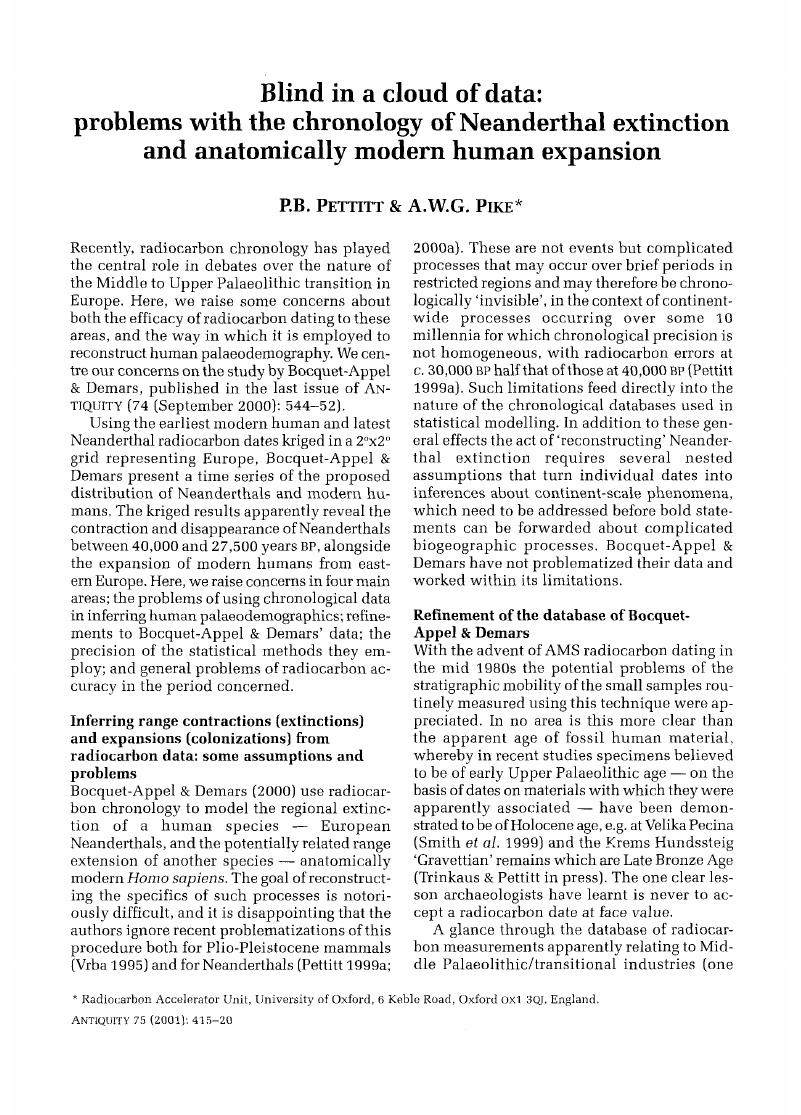Crossref Citations
This article has been cited by the following publications. This list is generated based on data provided by Crossref.
d’Errico, Francesco
and
Sánchez Goñi, Marı́a Fernanda
2003.
Neandertal extinction and the millennial scale climatic variability of OIS 3.
Quaternary Science Reviews,
Vol. 22,
Issue. 8-9,
p.
769.
Pettitt, Paul
and
Bahn, Paul
2003.
Current problems in dating Palaeolithic cave art: Candamo and Chauvet.
Antiquity,
Vol. 77,
Issue. 295,
p.
134.
Pettitt, P.B
Davies, W
Gamble, C.S
and
Richards, M.B
2003.
Palaeolithic radiocarbon chronology: quantifying our confidence beyond two half-lives.
Journal of Archaeological Science,
Vol. 30,
Issue. 12,
p.
1685.
van Andel, Tjeerd H.
2005.
The ownership of time: approved 14C calibration or freedom of choice?.
Antiquity,
Vol. 79,
Issue. 306,
p.
944.
Verpoorte, A.
2005.
The first modern humans in Europe? A closer
look at the dating evidence from the Swabian Jura
(Germany).
Antiquity,
Vol. 79,
Issue. 304,
p.
269.
Barrientos, Gustavo
and
Perez, Sergio Ivan
2005.
Was there a population replacement during the Late mid-Holocene in the southeastern Pampas of Argentina? Archaeological evidence and Paleoecological basis.
Quaternary International,
Vol. 132,
Issue. 1,
p.
95.
Burke, Ariane
2006.
Neanderthal settlement patterns in Crimea: A landscape approach.
Journal of Anthropological Archaeology,
Vol. 25,
Issue. 4,
p.
510.
Grün, Rainer
2006.
Direct dating of human fossils.
American Journal of Physical Anthropology,
Vol. 131,
Issue. S43,
p.
2.
Banks, William E.
d'Errico, Francesco
Peterson, A. Townsend
Kageyama, Masa
Sima, Adriana
Sánchez-Goñi, Maria-Fernanda
and
Harpending, Henry
2008.
Neanderthal Extinction by Competitive Exclusion.
PLoS ONE,
Vol. 3,
Issue. 12,
p.
e3972.
Nowell, April
2010.
Defining Behavioral Modernity in the Context of Neandertal and Anatomically Modern Human Populations.
Annual Review of Anthropology,
Vol. 39,
Issue. 1,
p.
437.
Martínez-Moreno, Jorge
Mora, Rafael
and
Ignacio de la Torre
2010.
The Middle-to-Upper Palaeolithic transition in Cova Gran (Catalunya, Spain) and the extinction of Neanderthals in the Iberian Peninsula.
Journal of Human Evolution,
Vol. 58,
Issue. 3,
p.
211.
Higham, Thomas
2011.
European Middle and Upper Palaeolithic radiocarbon dates are often older than they look: problems with previous dates and some remedies.
Antiquity,
Vol. 85,
Issue. 327,
p.
235.
Talamo, Sahra
Hughen, Konrad A.
Kromer, Bernd
and
Reimer, Paula J.
2012.
Debates over Palaeolithic chronology – the reliability of 14C is confirmed.
Journal of Archaeological Science,
Vol. 39,
Issue. 7,
p.
2464.
Neruda, Petr
and
Nerudová, Zdeňka
2013.
The Middle-Upper Palaeolithic transition in Moravia in the context of the Middle Danube region.
Quaternary International,
Vol. 294,
Issue. ,
p.
3.
Santamaría Álvarez, David
and
De la Rasilla Vives, Marco
2013.
Datando el final del Paleolítico medio en la Península Ibérica. Problemas metodológicos y límites de la interpretación.
Trabajos de Prehistoria,
Vol. 70,
Issue. 2,
p.
241.
2014.
Thin on the Ground.
p.
365.
French, Jennifer C.
2016.
Demography and the Palaeolithic Archaeological Record.
Journal of Archaeological Method and Theory,
Vol. 23,
Issue. 1,
p.
150.
Ontañon, Roberto
and
Utrilla, Pilar
2017.
The chronology of Palaeolithic cave art: New data, new debates. Preface to the volume.
Quaternary International,
Vol. 432,
Issue. ,
p.
2.
Vidal-Matutano, Paloma
and
Pardo-Gordó, Salvador
2020.
Predictive Middle Palaeolithic climatic conditions from Eastern Iberia: a methodological approach based on charcoal analysis and modelling.
Archaeological and Anthropological Sciences,
Vol. 12,
Issue. 1,
Albouy, Benjamin
Paquin, Simon
Hinz, Martin
Wren, Colin D.
and
Burke, Ariane
2023.
Modelling Human-Environment Interactions in and beyond Prehistoric Europe.
p.
27.



